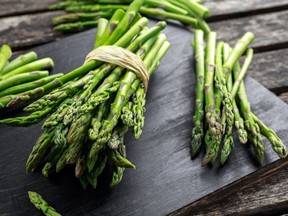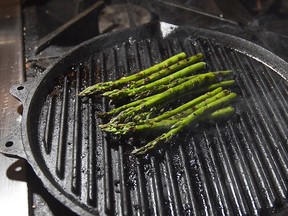Reviews and recommendations are unbiased and products are independently selected. Postmedia may earn an affiliate commission from purchases made through links on this page.
Local asparagus signals the fresh snap of spring

B.C.-grown asparagus is a revelation. Snappy, fresh, grassy — it tastes bright and hopeful, especially after a gloomy winter.

Article content
The cherry trees have bloomed, tourists are clustered around the Gastown steam clock and fresh, local asparagus is trickling into markets and restaurants. Could there be any surer sign that spring has, at long last, arrived in Vancouver?
Advertisement 2
Article content
After months of stringy imports that left most of their flavour behind in Peru or Mexico, the first bite of B.C.-grown asparagus is a revelation. Snappy, fresh, grassy — it tastes bright and hopeful, especially after such a long, gloomy winter.
Best of all, asparagus ushers in the season of easy cooking, of salads and barbecues and chilled glasses of straw-coloured wine. The best thing to do to asparagus is as little as possible, and that is just what we want to do in the kitchen when weather is nice.
Here’s how to enjoy spring’s best vegetable.

Shopping for asparagus
Asparagus can be green, purple or white, an herbaceous perennial plant that can live for two decades, producing long, pointy, delicious shoots year after year. It’s actually the young shoots of the plants that are eaten — left to their own devices, they become feathery and fernlike.
Advertisement 3
Article content
Asparagus likes temperate climates and cooler weather, so it is one of the first seasonal crops of the year here in B.C., first harvested in the Similkameen and Okanagan valleys in April, and elsewhere across the province in May. By the hot days of July, the season is over, although imports continue to arrive year-round from China, Mexico and Peru.
It’s that seasonality that makes local asparagus so expensive. That, and the fact that it can be finicky to grow and must be harvested by hand.
Even fussier is white asparagus, which is covered with soil or straw as it grows to prevent exposure to sunlight so photosynthesis can’t begin. The shoots stay white and its flavour becomes delectably nutty. Purple asparagus, on the other hand, is a variety developed in Italy, and is a bit sweeter than either green or white asparagus.
Advertisement 4
Article content
The first asparagus of the season tends to be thinner; the shoots get fatter as the season continues. Neither is a sure sign of tenderness; thin or fat, if asparagus is old or badly stored, it can become tough and flavourless.
The best advice is to buy asparagus as soon as possible after it is harvested. If possible, purchase it at farmers’ markets or stores that buy from local producers, and look for smooth skin, compact heads, freshly cut ends and a bright green colour.
As for storing asparagus, some people advise keeping it in a vase of water, as you would flowers; others suggest wrapping its ends in damp paper towels, then bundling it in a plastic bag and keeping it upright in the fridge.
But the best advice is simply to eat it as soon as possible.
Advertisement 5
Article content
Appreciating asparagus
Asparagus is good, of course, but it’s also good for you.
It is low in calories, and packed with essential vitamins, minerals and antioxidants that have been found to reduce blood pressure, inflammation and the risk of cancer and other ailments. It’s high in fibre and good for the digestion. And its high folate content supports a healthy pregnancy.
But perhaps more intriguingly, asparagus is said to be an aphrodisiac, though it’s debatable whether that’s because of its vitamin E and potassium content, or its, um, suggestive shape. The highly coveted tips are, after all, known as points d’amour, a.k.a. “love tips.”
We’ve been eating asparagus and since at least 3000 BCE. It is pictured on an ancient Egyptian frieze and the Roman Emperor Augustus famously described a quick action as “faster than cooking asparagus.”
Advertisement 6
Article content
By the 15th century, it was cultivated in French monastery gardens and served at Easter as a symbol of resurrection — after all, what could be more appropriate than a vegetable that spends most of the year resting underground, only to emerge in the daylight for a few short months?

Cooking asparagus
Once we’ve got our asparagus home, there are many ways to prepare it, though the best advice is to prepare it as simply as possible.
You can eat it raw, sliced thinly and tossed with vinaigrette in a salad. You can blanch it — simply plunge it into boiling salted water for a minute or two, depending on how thick it is, then rinse in cold water — and serve it with hollandaise or wrapped in prosciutto. You can make it into soup or add it to a pasta, risotto, frittata or stir fry. You can tempura it, grill it, roast it, pickle it or tuck it inside a sushi roll.
Advertisement 7
Article content
The key is to cook it quickly, otherwise it can become stringy and/or mushy and develop unpleasant cabbage-y aromas. The other thing to remember is to cut off the tough, woody ends before cooking; bend a spear slightly and you can usually sense where it needs to be trimmed.
We especially like asparagus baked in a tart with puff pastry and goat cheese — the creamy, tangy cheese is a perfect foil for its grassy, earthy notes.
Similarly, when pairing asparagus, look for crisp, refreshing white wines with good acidity. Sauvignon Blanc and Gruner Veltliner are classic pairings, but Pinot Gris, Riesling and sparkling wines are good choices as well.
But most of all, we love asparagus for its simplicity, its freshness, its versatility, and because once it arrives, we know that brighter days are on the way.
Advertisement 8
Article content
Asparagus and Goat Cheese Tart
The key to making something so simple taste so good is to use quality products such as fresh, local asparagus and all-butter puff pastry.
1 cup (4 oz) soft, fresh goat cheese, crumbled, at room temperature
1 large egg, lightly beaten, at room temperature
1/2 tsp fine kosher or sea salt, plus additional as needed
Pinch of freshly grated nutmeg
1 cup sour cream, at room temperature
All-purpose flour, for dusting the work surface
1 sheet all-butter puff pastry, thawed if frozen (about 14 ounces, but note that brands vary)
1 bunch asparagus, preferably thin stalks, woody ends trimmed so they are all equal lengths
Extra-virgin olive oil as needed
2 Tbsp grated Parmesan cheese, plus additional as needed
Advertisement 9
Article content
Freshly ground black pepper
Optional garnish: Italian parsley, chives or tarragon, chopped
Heat oven to 425°F and line a baking sheet with parchment paper.
In a medium-sized bowl, stir together goat cheese, egg, salt, pepper and nutmeg, then beat in the sour cream and continue mixing until smooth.
On a lightly floured surface, roll puff pastry into a rectangle about 10 by 14 inches, and 1/8-inch thick. Transfer the dough to the parchment-lined baking sheet. With a sharp knife, lightly score a 1-inch border around the edges of the puff pastry.
Spread the goat cheese mixture evenly inside the scored border. Arrange the asparagus spears neatly on top in a single layer and drizzle them with a little olive oil. Sprinkle asparagus with salt and grated Parmesan.
Advertisement 10
Article content
Place in the oven and bake until pastry is puffed and golden, 25 to 30 minutes. Let the tart cool on the baking sheet for at least 15 minutes and up to 4 hours. Sprinkle with black pepper, additional Parmesan and, if you like, some chopped fresh herbs and a drizzle of olive oil, cut into pieces and serve.
Serves 4
Risotto with Asparagus and Morels
This easy but impressive dish makes the most of spring’s freshest flavours. Note that you can sub other mushrooms (fresh or dried) for the morels, or even leave them out.
1 lb fresh morel mushrooms or 3 oz dried
6 cups chicken or vegetable stock
4 Tbsp olive oil
1 large shallot or 1 small onion, diced small
1/4 tsp red pepper flakes (optional)
2 cups arborio rice
½ cup dry white wine
3/4 cup grated Parmesan cheese, plus additional for serving
Advertisement 11
Article content
1 bunch asparagus, woody ends trimmed, cut into 1-inch pieces
Salt and freshly ground pepper to taste
Optional garnish: Fresh parsley or chives, chopped
If you are using fresh morels, rinse them well to remove any grit that might be trapped in the gills, then chop them roughly. If you are using dried morels, place them in a heatproof bowl and pour hot water over them; let them sit for a few minutes, until cool enough to handle, then chop them. Keep the umami-rich liquid to add to the risotto — just take care to strain out any gritty bits first.
Place the stock into a two-litre pot and bring to a simmer; keep warm throughout the cooking process.
Heat the oil in a Dutch oven or deep, large skillet over medium-high heat. Add the chopped shallots or onions and, if you like, the red pepper flakes, whichh add a subtle note of brightness to the dish, but are not essential. When the shallots are soft and translucent, add the mushrooms and cook for a couple of minutes until they are soft, all the liquid is gone and they start to brown.
Advertisement 12
Article content
Add the rice and stir well, making sure each grain is covered in oil. Add wine and cook until the alcohol has burned off, then add a ladleful of hot stock. Stir well. When the rice has absorbed the liquid, add more stock, and stir again.
Continue adding the stock and stirring until rice is plump and tender, but still firm to the tooth, about 20 minutes. Add the cheese and a bit more hot stock, and cook for another two or three minutes. Gently stir in the asparagus pieces, adding more stock if risotto looks dry — it should be thick and creamy. Season with salt and pepper.
If you like, garnish with chopped parsley or chives, and serve with additional Parmesan.
Serves 4
Grilled Asparagus with Goat Cheese
This is a perfect side dish with any grilled food. Creamy, tangy goat or feta cheese is a perfect foil for the grassy, smoky, charred notes of the asparagus.
Advertisement 13
Article content
1 bunch asparagus
1 Tbsp olive oil
Salt and pepper to taste
1 to 2 oz creamy goat cheese or, if you prefer, feta, crumbled
Trim the woody ends of the asparagus. Drizzle with olive oil and gently toss so the spears are lightly covered in oil.
Bring a grill to medium-high heat and place a grill basket on the grate. (This will help cook the asparagus evenly and, more importantly, prevent it falling through the grate.)
When it is nice and hot, add the asparagus. Cook until it starts to char, then use a pair of tongs to turn it gently; keep cooking and turning until you have nicely charred bits on all sides. This should only take a couple of minutes.
Remove asparagus from grill and place in a serving dish. Season with salt and pepper, then sprinkle with goat cheese or feta.
Serves 2 to 4 as a side dish
Source: vancouversun.com


